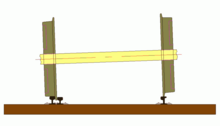Run-up curve
The approach curve is a special form of the railway superstructure , which enables track curves with a particularly small radius .
Since the axes of railway wagons cannot adjust radially or only to a limited extent ( steering axis ), they are inclined to the track in curves . Depending on the center distance and curve radius, the wheel sets clamp between the two rails , which leads to heavy wear on the wheel tires and rail heads. In the case of very sharp bends, driving on vehicles with a normal wheelbase is ultimately impossible. For this reason, arc diameters of less than 80 to 100 meters are usually avoided even with industrial tracks .
In order to still be able to lay tracks on narrow factory premises, the approach curve was developed in which curve radii down to 35 meters can be achieved. For this purpose, at the beginning of the curvature, the flange of the wheel running on the outer rail is guided over a ramp-like rail piece onto the rail head. Since the wheel set does not have to be guided by the flange of the wheel on the outside of the curve, a second rail profile is attached as a wheel guide next to the inner rail. Thus, the wheel on the inside of the curve guides the wheel set in both directions, while the outer wheel runs without constraints on the head of the outer rail.
The construction of Maschinenfabrik Deutschland GmbH in Dortmund , through which the run-up curve also became known as the Germany curve, became known. A similar version was produced as the Osnabrück type by Klöckner-Werke AG in Osnabrück.
There was at least one run-up curve that was simply made using an upturned rail. The rest, which is still in good condition, is at Kradolf in Switzerland. But it is already pretty overgrown.
